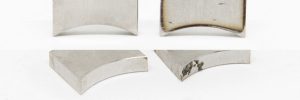
Following the introduction of the factors that affect the quality of laser cutting in the last article, then we discuss the standards that affect the quality of laser cutting. They can be summarized as follows:
1. Smooth cutting surface, no brittle fracture
When laser cutting a sheet with high temperature, the traces of molten material will form curved lines on the cutting surface and extend with the moving laser beam. To correct this problem, reducing the feed rate at the end of the cutting process can greatly eliminate the formation of lines and brittle fracture.
2. The narrow width of cutting slit
This is mainly related to the diameter of the laser beam spot, which depends on the quality of the laser tube. The cut width generally does not affect the cutting quality, but for the processing characteristics inside the part, the cut width determines the minimum inner diameter. In addition, as the sheet thickness increases, the cutting width also increases.
3. The verticality of the slit is good
When the processing material has a certain thickness, the verticality of the cutting edge must be paid attention to. Since the laser power density has a great influence on the verticality of the cutting, the choice of the focal length of the lens is an important issue.
The spot size of the laser beam after focusing is proportional to the focal length of the lens. If the beam is focused by the short focal length lens, the spot size is small, and the power density at the focal point is very high. It is good for material cutting. But the depth of focus is very short. The amount of adjustment is accordingly small. It’s generally suitable for high-speed cutting of materials with thin thickness. As for the telephoto lens has a wide focal depth, as long as it has sufficient power density, it is more suitable for cutting thick workpieces.
After determining which focal length lens is used, the relative position of the focal point and the surface of the workpiece is particularly important to ensure the quality of the cut. The highest power density is at the focal point. In most cases, the focal position is just at the surface of the workpiece or slightly below the surface during cutting.
During the entire cutting process, ensuring that the relative position of the focal point and the workpiece is constant is an important condition for obtaining stable cutting quality. Sometimes, the focal length changes caused by the heat of the lens due to poor cooling during working, which needs to adjust the focus position in time.
When the focus is in the best position, the slit is the smallest and the most efficient, and with the suitable cutting speed can get the best cutting results.
4. Thermal effects of cutting materials
Laser cutting is a kind of thermal cutting processing application. It is bound to cause thermal impact on the material during its machining, which mainly includes three aspects:
- Heat affected area
- Depression and corrosion
- Deformation
The heat-affected area refers to the area along the incision that is heated during laser cutting. It changes the structure of the material itself, such as hardening. It may also cause depression and corrosion of the cutting edge. If cutting sharply heats the part, it might cause deformation. Controlling laser power can reduce component heating and avoid distortion.
Inspecting parts through the above standards can more efficiently and comprehensively obtain parts of ideal quality. It also can greatly avoid problems that occur during production, assembly and use.
You can find the photo display of the CNC machining parts made by us HERE
